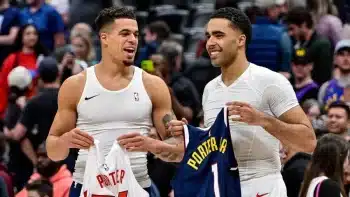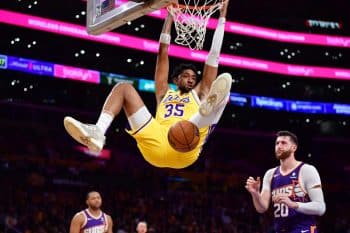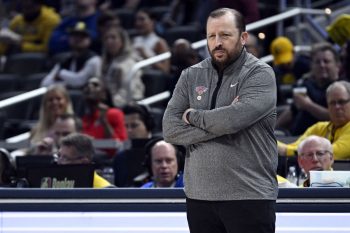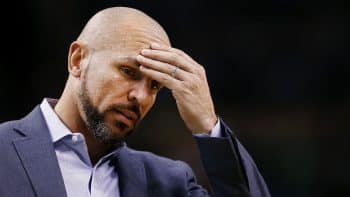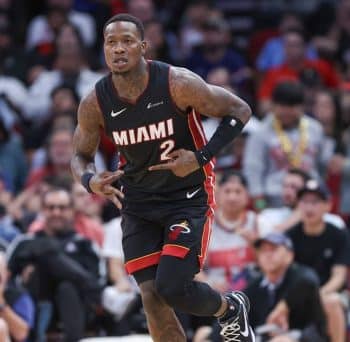NBA
Young Moe Harkless Set For Big Pay Day
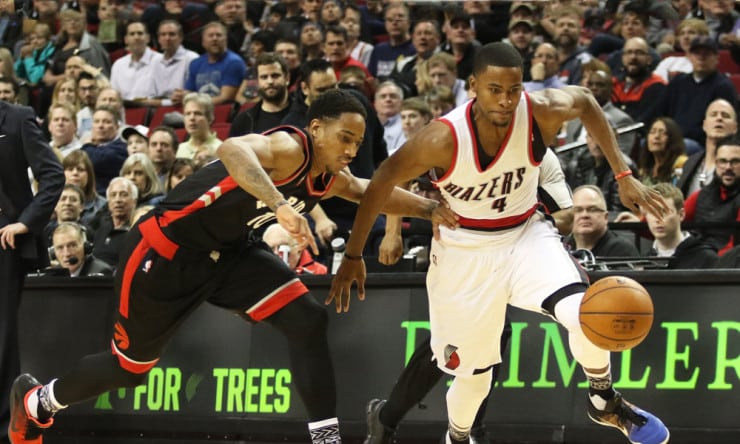
It’s easy to forget that Portland Trail Blazers forward Moe Harkless just turned 23 years old last month. He was the second-youngest player in his draft class, so he still has untapped potential despite the fact that he’ll be entering his fifth NBA season when the 2016-17 campaign gets underway.
In fact, Harkless is even younger than some of prospects in this year’s NBA draft – including A.J. Hammons, Michael Gbinije, Sheldon McClellan, Gary Payton II and Dorian Finney-Smith among others.
“Sometimes I forget the fact that I’m only 23 years old. Like, this year, I was younger than two of the rookies on our team,” Harkless told Basketball Insiders with a laugh. “There are some guys in this draft class who are a little bit older than me. When people bring that stuff to my attention, it’s just crazy to think about. I know I still have so much room to grow and get better still.”
This combination of upside and NBA experience will make Harkless an attractive target for potential suitors in July. He is a restricted free agent now that the Blazers officially extended a $4,045,894 qualifying offer, meaning they can match any offer sheet he receives from another team.
This summer will see the salary cap spike from $70 million to an unprecedented $94 million (thanks to the NBA’s new television rights deal). That’s excellent news for a player like Harkless, who should have no shortage of potential suitors on July 1 thanks to his versatility and continued development. In addition to the Blazers, the Detroit Pistons, Washington Wizards, Chicago Bulls, Los Angeles Lakers and Dallas Mavericks have already expressed interest in Harkless, according to sources close to the situation.
“The main things I’m looking for are being in a situation where I’m comfortable, where there’s a winning culture and where there’s playing time,” Harkless said. “The money is kind of whatever. I mean, every guy wants as much money as possible, but I’m more looking to be in a good situation where I can be happy and win games.
“Honestly, I’m at a weird stage because I don’t know what to expect. I’ve never been in this situation before. I’m excited about going through it, but I don’t know what’s going to happen. And I haven’t even asked what it’s going to be like, because I just want to experience it for myself. I’m really looking forward to it and I can’t wait for the process to start. It’s kind of like being recruited to a college. That was exciting for me, and now I’m looking forward to see how this goes.”
Few players get to test the market at such a young age, and the timing is perfect for Harkless since he’s coming off of a strong campaign in which he thrived individually and helped Portland make an improbable postseason run. Blazers head coach Terry Stotts put Harkless in positions to succeed and Harkless responded by producing down the stretch of the regular season and in the playoffs.
Over the last year and a half, it was interesting to watch Harkless make the transition from wide-eyed youngster to two-way difference-maker on a team that advanced to the Western Conference Semifinals and stole a game against the 73-win Golden State Warriors (as well as forcing overtime against them in Game 4).
Harkless’ transformation from the kid who used to dump bags of Skittles into the shoes of unsuspecting Orlando Magic teammate Elfrid Payton to the man who wants to defend every opposing team’s star has been encouraging (particularly for Portland, assuming they can keep him).
With the Magic, Harkless was still adjusting to the NBA, developing his game and growing his confidence – which is understandable given his age and the situation he was thrust into. It also didn’t help that former head coach Jacque Vaughn didn’t always utilize Harkless correctly. Coach Vaughn would often have Harkless stand in the corner waiting for a pass rather than being more aggressive and moving without the ball. Vaughn also tried some strange techniques, such as benching him for extended periods of time with no explanation other than wanting to see how Harkless would react.
Orlando eventually traded Harkless to Portland for a second-round pick that will never be conveyed (so they got nothing), which also frustrated some players on the team. Harkless was known for getting along with everybody; he cracked jokes and hung out with Victor Oladipo, helped bring the quiet Elfrid Payton out of his shell (even if he had to step on some Skittles in his Nikes along with the way) and brought Kyle O’Quinn to his offseason workouts at the IMG Academy so they could train together and strengthen their friendship. Teammates also described him as the kind of player who would get frustrated if someone was prioritizing individual achievements over the team’s success. Not to mention, Harkless was always welcoming of any new player, media member, employee or fan he came into contact with, flashing his smile and making them feel comfortable.
Harkless’ former teammates were upset to see him go, but they loved watching him flourish with the Blazers and show what he could do on the postseason stage.
“Moe was great in the locker-room,” Elfrid Payton told Basketball Insiders. “Despite the way he was utilized, he never let that stop his work ethic. He was always ready when his number was called, kind of how he was in Portland during these playoffs. It was great to see him play well on that stage.”
“Moe is a true teammate who cares about winning,” said current New York Knicks big man Kyle O’Quinn, who played with Harkless in Orlando. “He’s a hard worker who’s always trying to add to his game and he’s open to play any position that’s asked of him. He can be a ‘3-and-D’ guy, especially since he can guard positions one through four.”
While Harkless was initially disappointed to leave his friends, the familiarity of Orlando and the up-and-coming Magic organization, it soon became clear that the move was a blessing in disguise.
In Portland, he found a talented head coach in Stotts and they succeeded once they got on the same page. Harkless realized that he could leave his fingerprints all over every game by being a two-way threat on a legitimate playoff team.
“I think he’s a great coach and he’s done a great job with the team,” Harkless said of Stotts. “Playing for him, he put me in a lot of different situations to succeed, especially later on in the year, and I really appreciated that. In my opinion, I think he should’ve won Coach of the Year.”
He continued to add muscle and strengthen his reputation as a versatile defender, so his skill set and swagger were catching up with his intimidating combine measurements of 6’9 with a 7’0 wingspan and 37-inch vertical. He also embraced that ‘3-and-D’ role and believes the way the league is shifting is great for an individual with his skill set.
“I think it’s perfect for a guy like me, who can do a lot of different things on the court,” Harkless said. “The way that the league is transitioning, it’s kind of like a position-less game where a lot of teams are starting to go small. There will obviously always be big guys out there, but even the bigs need to be more versatile now and need to be able to switch onto guards and things like that. Being a guy who can play multiple positions and defend multiple positions, I love it. I’m excited about it.”
This season, Harkless averaged 6.4 points and 3.9 rebounds per game. But when Coach Stotts increased Harkless’ playing time, his production spiked as well. In April, Harkless averaged 11.8 points, 6.5 rebounds, 1.5 steals and one block in 28.7 minutes per game (while shooting 37.5 percent from three-point range on nearly three attempts per game).
In his 14 games as a starter throughout the season, Harkless averaged 11.9 points, 6.6 rebounds, 1.2 steals and one block in 26.9 minutes. Much like he had done in Orlando with consistent playing time, Harkless made the most of his opportunity. His per-100-possession numbers – 17.1 points, 9.6 rebounds, 2.3 assists, 1.7 steals and 1.2 steals – back this up. Throughout the season, he scored in double figures on 23 occasions.
After the All-Star break, when Harkless’ minutes increased from 17.2 to 21.6 per game and he was moved into the starting lineup for 11 contests, the Blazers started playing some of their best basketball. They finished the campaign winning 17 of their final 28 games. Perhaps most telling is that Portland’s best starting unit of the season consisted of Damian Lillard, C.J. McCollum, Al-Farouq Aminu, Harkless and Mason Plumlee. The lineup had a +19.1 net rating, taking advantage of the versatility and two-way effectiveness of Harkless and Aminu (along with Plumlee doing the dirty work and, of course, Lillard and McCollum’s terrific one-two punch on the offensive end).
A big reason for Harkless’ growth can be attributed to the fact that this was his first time on a team that expected to win every night when they entered the arena. The Magic never won more than 25 games while Harkless was in Orlando, as the team was going through a lengthy rebuilding effort. But in Portland, Harkless was paired alongside an All-Star in Lillard, the league’s Most Improved Player in McCollum, the Coach of the Year runner-up in Stotts and veterans like Chris Kaman, Mason Plumlee, Ed Davis and Gerald Henderson among others who instilled confidence in the group. This supporting cast was excellent for Harkless’ maturation, and the Blazers managed to win 44 games and secure the fifth spot in the intensely competitive Western Conference.
Come playoff time, the young swingman stepped up even more, as his averages increased to 11 points and 5.1 rebounds in just 24.7 minutes while playing terrific defense and knocking down 34.1 percent of his three-point attempts (on four attempts per game). Without Harkless, upsetting the L.A. Clippers in the first round would’ve been a much tougher task. In Portland’s four-straight victories to advance past the Clippers, Harkless scored in double figures in each game. He contributed 55 points and 27 rebounds over that four-game span while shooting 51.2 percent from the field and 35.3 percent from three-point range (while playing very solid defense).
Looking at Harkless’ postseason as a whole, he scored in double figures in eight of 11 playoff games. His per-100-possession stats in the playoffs were very solid: 22.2 points, 10.3 rebounds and 1.8 steals. That would be impressive for any player, but especially for a kid making his postseason debut and battling star-studded contenders like the Clippers and Warriors on the NBA’s biggest stage.
“First of all, getting to the playoffs was just an amazing experience,” Harkless said. “That’s what we worked all year for and, when you’re playing for a championship, it’s an opportunity that everybody dreams about. Being able to go to the playoffs and play for something so precious like an NBA championship is an amazing feeling. We won our first playoff series this year, and I don’t even know how to explain what that feels like. And the best part is that we won at home. It was just amazing. The level of intensity and focus in the playoffs is just so much higher since you’re playing the same team over and over so you know their plays, what each player is trying to do and all of that. I can’t really put it into words, but the feeling is just crazy.”
Harkless’ Portland teammates have welcomed him with open arms and see how important he is to the squad.
“Moe is one of those teammates who’s just special to me,” Lillard told Basketball Insiders. “I have so much respect for him as a person, but to watch him work through not playing and then be rewarded for that [hard work] was awesome. He changed our season.”
“Moe was very valuable to our team last season,” McCollum added. “His versatility and relentlessness were some of the main reasons we were able to have success down the stretch. He battled through being in and out of the rotation early on in the season, and then came up huge for us when we needed him the most.”
Harkless picked a good time to break out. Many players entering the market this summer are looking to make over $10 million per year. While the casual observer may think that’s unrealistic for Harkless, remember that teams are paying based on potential and what kind of contributor a player can become rather than who they are today. Think about Charlotte Hornets swingman Michael Kidd-Gilchrist earning $13 million per year despite his lack of a jump-shot and some of his injury concerns. And that was before the salary cap soared.
Those who paid close attention saw that Harkless made huge strides this year.
With a better-defined role in his first year with the Blazers, his True Shooting percentage jumped nearly 10 full points, showing he was playing much more efficiently. Also, he posted his best rebounding season by percentage since entering the league, and he lowered his turnover rate even while increasing the share of Blazers possessions he used while on the floor.
But perhaps most impressive was his improved ability to finish at the rim. During his final year in Orlando, Harkless shot 59 percent within three feet of the hoop; this year, he shot 66 percent within three feet. Last year, he shot 4.5 attempts per-36-minutes within five feet and hit 56.5 percent. This year, he shot 5.8 attempts per-36-minutes within five feet and hit 62 percent. Put simply, he played well over double the minutes, attempted more shots near the basket per minute and hit at a higher clip.
This is a vital part of his development and one that was aided by his efforts to bulk up during the 2015 offseason. He told Basketball Insiders that his weight for the 2015-16 season was between 220 and 225 lbs. while in previous years with the Magic he fluctuated between 210 and 215 lbs. Not only did he seem visibly bigger, he said that he felt much stronger and the added weight helped his confidence.
Harkless is no longer the scrawny teenager trying to find his way in the NBA. Now, he’s a confident veteran who knows he can hold his own against anyone, making a big impact on both ends of the court even when he’s staring down the best players in the world.
The 6’9 forward loves guarding the opposition’s best player. In the Blazers-Warriors series, he took on Klay Thompson, whose field goal percentage dropped by 23 percent from Game 1 to Game 2 after Harkless took on the assignment to guard him. During the year, Harkless also spent time guarding LeBron James, who had just 12 points (below his 25.3 season average). He guarded Chris Paul, who had 16 points and four assists in 34 possessions guarded by Harkless (below his season averages of 19.5 points and 10 assists). He also spent significant time on Kevin Durant, James Harden, Paul George, Draymond Green and Carmelo Anthony among others, showing his defensive versatility (which is valued in today’s switch-everything, position-less NBA).
“Moe was huge for us,” Ed Davis said. “He wasn’t getting consistent minutes in the beginning of the year, but once Coach Stotts started playing him more, he was our X-Factor.”
Harkless does a lot of things that are just now starting to show up on the stat sheet. For example, the NBA just started tracking hustle plays for this year’s postseason and Harkless’ 1.8 deflections per game put him in the top 30 – tied with players like Stephen Curry, Hassan Whiteside and Andre Drummond (even though he played far fewer minutes than them).
ESPN’s Real Plus-Minus metric – which parses an individual player’s cumulative contribution to their team while controlling for teammate and opponent quality along with an additional box score element – reveals some interesting info too. Harkless’ RPM ranked above fellow upcoming free-agent forwards such as Harrison Barnes, Kent Bazemore, Jeff Green and Matt Barnes among others.
With that said, he did have a number of traditionally impressive box-score performances this season too. In a February victory over the Houston Rockets, he posted 19 points (on 8-11 shooting from the field), 13 rebounds and two steals in 28 minutes. In an April win over the Sacramento Kings (when Harkless was really picking up momentum), he had 20 points, 16 rebounds, two assists and two steals in 33 minutes.
Because Harkless does have so much untapped potential, it’s these glimpses of brilliance that will make a potential suitor very tempted to enter a bidding war for him. With the direction the league is shifting, Harkless could be a perfect “3-and-D” player or even bring more to the table if he continues to hone his skills. His jump-shot must continue to improve, but he knows that and he’s working on it a ton this offseason while training in California and Florida.
“I feel like I still have so, so, so much room to improve – and I’m talking about every part of my game,” Harkless said. “And you’ve seen me work out in the offseason, I work on literally everything. I feel like I can just keep improving on every part of my game, and I’m still just the same hard-working kid that I’ve always been. I’m looking forward to getting better. Now that I’ve been to the playoffs and experienced what it feels like, I want to get back more. It’s made me even hungrier.”
When asked about this Blazers team, Harkless says that he believes a lot of their success comes from their off-court relationships and chemistry.
“We were always around each other because this was a really close group of guys,” Harkless said. “The chemistry on this team was excellent and I think that’s a reason why we were able to be so good. We all enjoyed playing with each other and had fun with each other, so I think that really helped us too. I think when everyone likes each other and is always together, it helps a lot. It makes it easier to play together.
“We’d all go to the movies together, for example. Dame would throw skate parties and we’d all go to the skating rink. Dame would have everyone over to his house, or invite everyone on the team out for dinner on the road. Stuff like that, it definitely helps because your close, your chemistry is better and it translate onto the court because you’re on the same page and, if you do have to yell at each other or something, nobody takes it personally because you all get along. All of that plays a role in chemistry and culture, and I think Dame did a great job this year of bringing guys together.”
He has also grown to appreciate the unique city of Portland.
“It’s different; that’s what I tell everyone when they ask me about it. I love the city – there’s really good food, it’s beautiful (especially during the summertime) and the fans are amazing,” Harkless said. “I would say the fan base is one of the best in the league. Even when I was in Orlando, I’d say that. I hated coming to Portland because it was one of the toughest arenas to play in. Now, having that fan support and seeing the diehards, it’s awesome. They roll with us no matter what, when we were losing in the beginning to the fun ride later in the season. It was cool and I really liked being in Portland. The organization is first-class and I’ve enjoyed my time there for sure.”
Now, however, Harkless knows that it’s time to make a business decision. He has already been traded more than once in his NBA career, and he knows that nothing is guaranteed in this league. While he’d love to be back in Portland, he’s weighing all of his options and entering this process like a professional.
“I love Portland, but there are a lot of other great organizations and I also understand that the NBA is a business,” Harkless said. “I’m going to lean on my agents, so they can do what’s best for me.”
